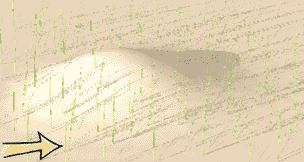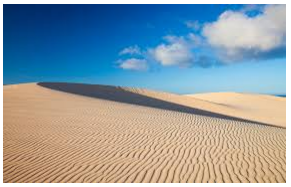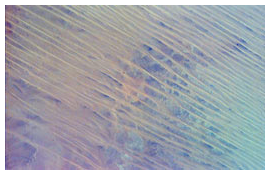By: Madeline Kollegger and Taylore Grunert
Parabolic
Parabolic dunes – also called U-shaped, blowout, or hairpin dunes – tend to form where vegetation covers the sand. Winds may erode a section, pushing the sediment leeward. The vegetation will hold back the arms of the dune, so that the dune points in the leeward direction. The animation below gives a basic overview of how they form. They are most common in coastal deserts. Sometimes, parabolic dunes can come from transverse or barchan dunes, given that the dunes stay static enough for vegetation to grow on them.

(National Park Service)
Star
Star dunes are a rare, interesting dune structure, that pepper landscapes in sandy deserts. They form when alternating and multiple wind directions pile sand in a location, and forms a peak, with many arms extending from the center (Fun Facts…). Star dunes make up 8.5% of all the dunes on the planet, and they often form in large groups in a dune field (Star Dunes). Many of these fascinating dunes can be seen in the Sahara desert, especially in the Grand Erg Oriental, a “sand sea” of dunes.
Barchan
Barchan dunes are crescent or half-moon shaped, and are thus also called crescentic dunes. They form where conditions are ideal. They require a flat landscape, winds from only one direction, and limited sand. However, these exact conditions are rare, and so is this type of dune, although they are found in all types of deserts. Barchan dunes point against the wind. Their faces are steep, but their trailing sides are not. They will often join up with other barchans to form barchanoid ridges.

(World Landforms)
Longitudinal
Also called linear dunes, longitudinal dunes look like large, parallel needle-esque features on the landscape. They are straight, and long, unlike the typical dune that people imagine. This dune type forms when sand is not in excess, and when wind blows in one constant direction. Over an extended period of time the dunes will migrate in the direction the wind is blowing.
The below dunes are in Egypt.

(NASA EarthKam)
Works Cited
“Barchan Landforms”. World Landforms, n.d. Web. Retrieved Feb. 6, 2017 from http://worldlandforms.com/landforms/barchan/
Blumberg, Dan G. and Haim Tsoar. “Formation of Parabolic Dunes from Barchan and Transverse Dunes Along Israel’s Mediterranean Coast.” Earth Surface Processes and Landforms, vol. 27, no. 11, pp. 1147-1161, 2002.
“Dune Types.” National Park Service, n.d. Web. Retrieved Feb. 6, 2017, from https://www.nps.gov/grsa/learn/nature/dune-types.htm.
“Star Dunes.” DKfindout!, n.d. Web. Retrieved February 06, 2017, from http://www.dkfindout.com/us/earth/deserts/star-dunes/
Star Dunes in Algeria. (n.d.). Retrieved February 06, 2017, from http://earthobservatory.nasa.gov/IOTD/view.php?id=81996
“Types of Dunes.” Exploring Earth, n.d. Web. Retrieved from https://www.classzone.com/books/earth_science/terc/content/investigations/es1603/es1603page04.cfm
“Types of Dunes.” USGS, n.d. Web. Retrieved Feb. 6, 2017, from https://pubs.usgs.gov/gip/deserts/dunes/